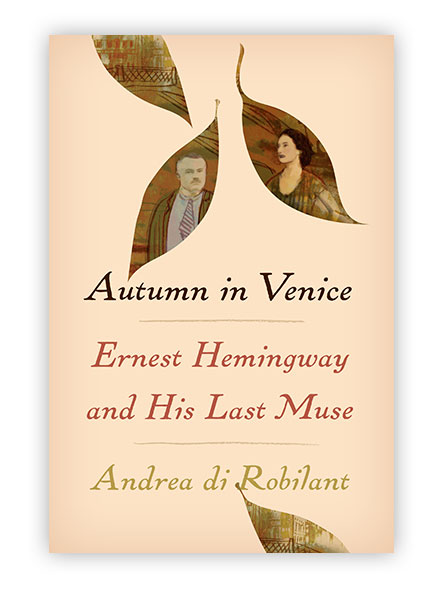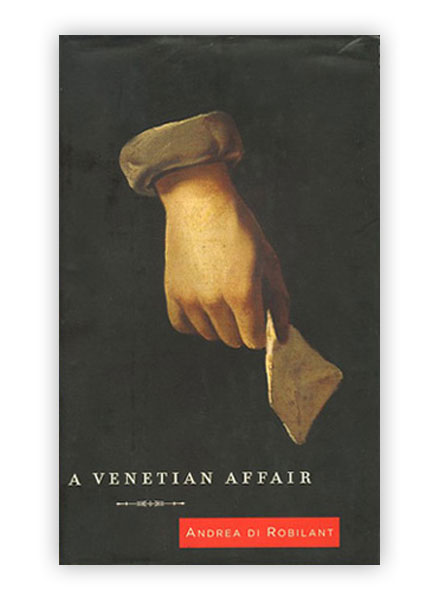
Autumn in Venice: Ernest Hemingway and His Last Muse
Published by Knopf, 2018
“Andrea di Robilant gives us the remarkable story of Ernest Hemingway’s love affair with both the city of Venice and the muse he found there – a vivacious eighteen-year-old who inspired the man thirty years her senior to complete his great final work. In the fall of 1948 Hemingway and his fourth wife, Mary Welsh, traveled for the first time to Venice, which Hemingway called “absolutely god-damned wonderful.”
He was year shy of his fiftieth birthday and hadn’t published a novel in nearly a decade. A t a duck shoot in the lagoon he met and fell in love with Adriana Ivancich, striking Venetian girl just out of finishing school. Andrea di Robilant – whose great uncle moved in Hemingway’s revolving circle of bon vivants, aristocrats, and artists – re-creates with sparkling clarity this surprising, years-long relationship. Hemingway used Adriana as the model for Renata in Across the River and into the Trees, and continued to visit Venice to see her; when the Ivanciches traveled to Cuba, Adriana was there as he wrote The Old Man and the Sea. This illuminating story of writer and muse – which also examines the cost to a young woman of her association with a larger-than-life literary celebrity – is an intimate look at the fractured heart and changing art of Hemingway in his fifties.

Chasing the Rose: An Adventure in the Venetian Countryside
Published by Knopf, 2014
A charming chronicle of his search for the identity of a mysterious old rose. Andrea di Robilant's tale takes us back to the time of Josephine Bonaparte, as well as into some of the most delightful rose gardens in Italy today, brought to colorful life on the page in the watercolors of artist Nina Fuga.
In his 2008 biography of the Venetian lady Lucia Mocenigo (his great-great-great-great- grandmother), di Robilant described a pink rose that grows wild on the family's former country estate, mentioning its light peach-and-raspberry scent. This passing detail led to an invitation for an audience with a local rose doyenne, Eleonora Garlant. She and other experts wondered if di Robilant's unnamed rose could possibly be one of the long-lost China varieties that nineteenth-century European growers had cultivated but which have since disappeared. On the hunt for the identity of his anonymous yet quietly distinctive rose, Di Robilant finds himself captivated by roseophiles through time–from Lucia and her friend Josephine Bonaparte to the gifted Eleonora, whose garden of nearly fifteen hundred varieties of old roses is one of the most significant in Europe––and by the roses themselves, each of which has a tale to tell.
What starts out as a lighthearted quest becomes a meaningful journey as di Robilant contemplates the enduring beauty of what is passed down to us in a rose, through both the generosity of nature and the cultivating hand of human beings, who for centuries have embraced and extended the life of this mysterious flower.

Irresistible North (Knopf) / Venetian Navigators (Faber)
Published by Knopf and Faber, 2011
While working in the Biblioteca Marciana in Venice, Andrea di Robilant came across a curious map of the North Atlantic published in 1558. It was attached to the back of a small book with an alluring title: On the Discovery of Frislanda, Estlanda, Engroveland, Estotilanda, Drogio and Icaria under the North Pole. It turned out to be a travel narrative describing the fourteenth century journey of two Venetian merchants and navigators, the brothers Nicolò and Antonio Zen. Both the book and the map had had a great impact on late Renaissance geography and cartography. Queen Elizabeth herself relied on the Zen narrative to establish the foundations of a British Empire in the North Atlantic. But in the 1830s a Danish admiral stunned the world by denouncing the book as one of the great forgeries of all time. Forty years later a report by the chief geographer of The Royal Geographical Society reached the opposite conclusion, and what had long been considered “one of the greatest puzzles of all literature was no longer a puzzle at all.” But the stain of forgery never really went away and the story of the Zen brothers gradually faded into oblivion. Part travel narrative, part investigative history, Irresistible North brings back to life this fascinating yet baffling Venetian saga as Andrea di Robilant follows the footsteps of Nicolò and Antonio Zen from Venice to Orkney, Shetland,
the Faroes, Iceland and as far as Greenland.
read more...

Lucia: A Venetian Life in the Age of Napoleon
Published by Knopf, 2008
In 1787, the beautiful Lucia Memmo is married off to Alvise Mocenigo, scion of one of the most powerful Venetian families. But their life as a golden couple is suddenly transformed when Venice falls to Bonaparte. We witness Lucia's painful series of miscarriages and the pressure on her to produce an heir; her impassioned affair with an Austrian officer; the glamour and strain of her career as a hostess in Vienna; and her amazing firsthand account of the defeat of Napoleon in 1814. In this rich and fascinating sequel to A Venetian Affair, Andrea di Robilant has once again reached across the centuries, and deep into his own past, to bring history to vivid life on the page.read more...

A Venetian Affair
Published by Knopf, 2003
In the waning days of Venice's glory in the mid-1700s, Andrea Memmo was scion to one the city's oldest patrician families. At the age of twenty-four he fell passionately in love with sixteen-year-old Giustiniana Wynne, the beautiful, illegitimate daughter of a Venetian mother and British father. Because of their dramatically different positions in society, they could not marry. And Giustiniana's mother, afraid that an affair would ruin her daughter's chances to form a more suitable union, forbade them to see each other. Her prohibition only fueled their desire and so began their torrid, secret seven-year-affair, during which they enlisted the aid of a few intimates and servants (willing to risk their own positions) to shuttle love letters back and forth and to help facilitate their clandestine meetings. Eventually, Giustiniana found herself pregnant and she turned for help to the infamous Casanova – himself infatuated with her.
Two and half centuries later, the extraordinary story of this star-crossed couple is told in a breathtaking narrative, re-created in part from the assionate, clandestine letters Andrea and Giustiniana wrote to each other.
read more...